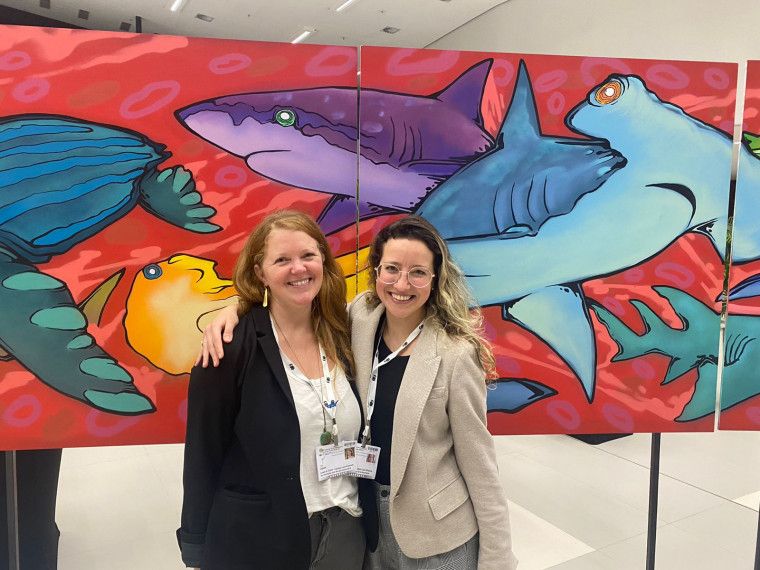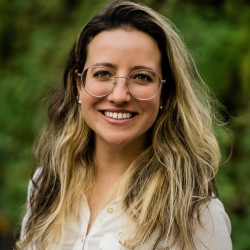Creating Change for Animals at CITES CoP19
Vanessa Gischkow Garbini (Animal Law LLM ’22, Brazil) reflects on her recent experience attending CITES CoP19 and why it gave her hope for addressing the loss of wild animals’ lives and stopping the extinction crisis.
Open gallery

As an Animal Law LLM student, I had the opportunity to participate in the International Wildlife Law Clinic with Clinical Professor Erica Lyman, where I began my study of the Convention on International Trade in Endangered Species of Wild Fauna and Flora (CITES). As a student in the Clinic, I aspired to someday participate at CITES meetings to advance the dialogue regarding protecting animals in my home country of Brazil. Little did I know that only one year later, I would be in Panama City, Panama, having the priceless opportunity to observe in practice all that we learned in the Clinic, along with my fellow Animal Law LLM alumni: Kui Guchuhi (’17, Kenya), Ever Chinoda (’17, Zimbabwe), Gladys Kamasanyu (’20, Uganda), and Yvonne Guirra (’22, Zimbabwe). All of us represented governments and civil society while working together to protect wild animals.
As I sat next to Professor Lyman, right behind our official name plate identifying us as “Lewis & Clark–Global Law Alliance for Animals and the Environment,” I thought back to my first day as an Animal Law LLM student at Lewis & Clark Law School. I can clearly remember Professor Lyman telling us that her main goal was that we would complete our studies as “CITES experts” who might someday participate in the treaty negotiations, representing our country’s civil society’s animal protection goals.
After a year of thoroughly studying the Convention, understanding its weaknesses and strengths in terms of effectiveness and learning about the emerging topics addressed by the Convention, there I was participating. Attending the CoP19 felt like coming full circle. It complemented the theoretical knowledge on CITES that I acquired during my LLM studies and added a completely different dimension that one can only understand by being there. What most impressed me was watching how coalitions work, especially the willingness of many non-government organizations (NGOs) to gather forces and become influential networks in support of animals and nature. I was also surprised to realize how open some countries are to dialogue with NGOs.
As a Brazilian lawyer, I followed the many proposals supported by Brazil at the CITES meeting. Most of these were in favor of enhanced protections for animals and plants, including the important tree species Brazilwood. Brazil authored or co-authored proposals for the protection of several animals, such as turtles, frogs, sharks, stingrays, and fish. I was struck by the vast array of animal species around the world whose very existence is at stake due to human use and exploitation and how CITES can be effectively used as a tool to save their lives
One of the “stars” of the Conference, the glass frogs (Centrolenidae spp.), also counted on Brazil’s help to be protected. Glass frogs are gorgeous creatures that live exclusively in the humid forests of Central and South America, who are sadly highly targeted by the exotic pet trade (see here for an FAQ about glass frogs). Their inclusion in Appendix II of CITES will help protect them, by enabling control over international trade, imposing welfare constraints that did not exist prior to inclusion, and better equipping the countries home to these frogs with enforcement tools to ensure their survival in the wild.
Another addition to Appendix II was Shyrnidae spp., also known as Hammerhead sharks. These apex predators are at risk around the world due to commercial fishing, primarily for the shark fin trade. Not only do they face gruesome deaths from shark finning, but their numbers have plummeted as a result of the practice, throwing ecosystems out of balance. Brazil joined forces with Colombia, Ecuador, Panama, and the European Union to ensure that the risks to Hammerheads are managed in a way that prevents them from being driven to extinction by international trade.
Brazil was the sole proponent of proposals to list two freshwater stingrays (Potamotrygon Wallacei and P. leopoldi) and a small, very beautiful fish called zebra pleco (Hypancistrus zebra), all endemic to Brazil and highly threatened by the ornamental fish trade. The pleco zebrafish was uplisted from Appendix III to Appendix II, and because all international trade is illegal, this should provide a means to elevating the enforcement responsibilities and providing greater cooperation to tackle illegal trade. The freshwater stingrays were also included in Appendix II.
It is easy to read CITES as a student and become overwhelmed by enforcement challenges, the exceptions to its restrictions, and the sustainable use underpinnings of some of its provisions. But a listing such as the entire genus of glass frogs and all of the shark species that were included on the CITES Appendices is also a hopeful step toward greater protections and a positive signal to those who only see shortcomings and weaknesses when studying the treaty in class. Professor Lyman would often say that for all of the academic criticism of CITES, it is hard to under-estimate its value to all of the myriad species who enjoy what protection it does offer. Witnessing successful listings in real life gave me hope that CITES will play a part in addressing the loss of so many wild animals’ lives as the extinction crisis unfolds.
Attending the Cop19 has not only equipped me with practical knowledge on CITES, but has provided me with essential tools for my future endeavors to help advance animal protection globally. This experience made me a more strategic and effective advocate, and has inspired me to continue giving my best to the cause of animal protection on the international stage. A special thank you to the Center for Animal Law Studies and Professor Lyman for making it possible.

The Center for Animal Law Studies (CALS) was founded in 2008 with a mission to educate the next generation of animal law advocates and advance animal protection through the law. With vision and bold risk-taking, CALS has since developed into a world-renowned animal law epicenter. CALS’ Alumni-in-Action from over 20 countries are making a difference for animals around the world. CALS is a nonprofit organization that is funded through donations and grants.
More Center for Animal Law Studies Stories
Center for Animal Law Studies is located in Wood Hall on the Law Campus.
MSC: 51
email cals@lclark.edu
voice 503-768-6960
Center for Animal Law Studies
Lewis & Clark Law School
10101 S. Terwilliger Boulevard MSC 51
Portland OR 97219


